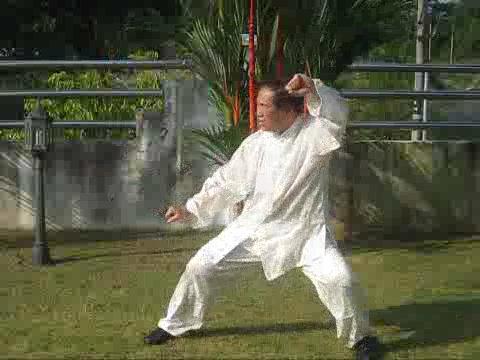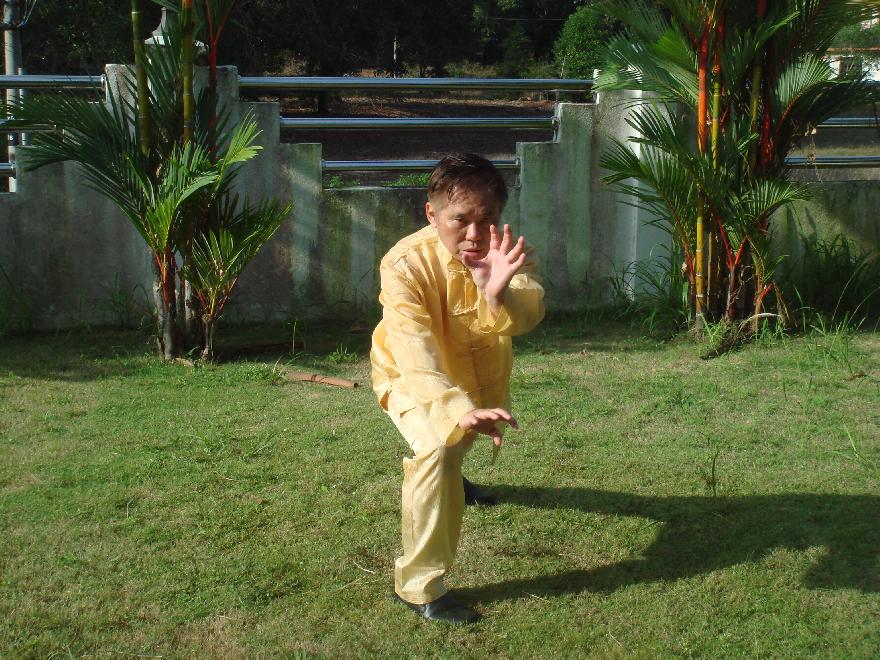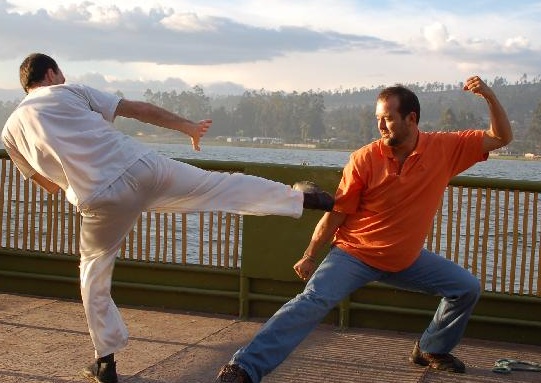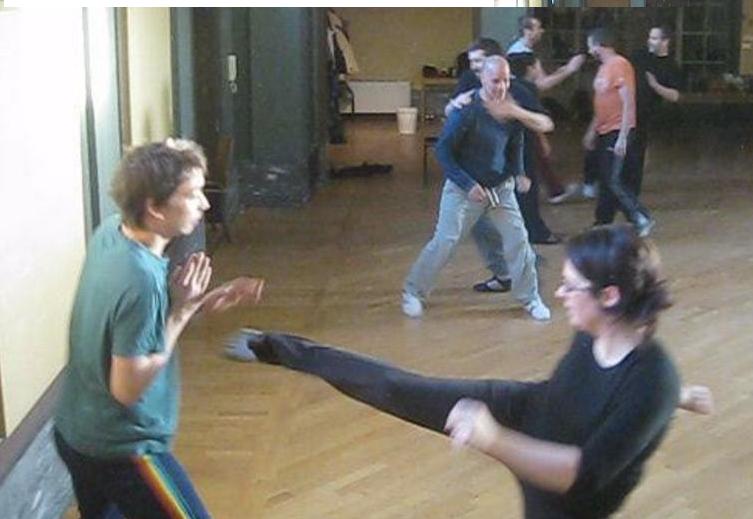SELECTION OF QUESTIONS AND ANSWERS
AUGUST 2013 PART 1

You will be amazed at what you can learn at an Intensive Tai Chi Chuan Course
Question 1
Sifu, you told us that you did not learn Tai Chi Chuan formally from any teacher. But how is it that your Tai Chi Chuan is so good?
— Priya, India
Answer
Thank you for your compliments.
There are a few reasons why my Tai Chi Chuan is good even though I did not formerly learn Tai Chi Chuan from a teacher.
Firstly, everything in Tai Chi Chuan can be found in Shaolin Kungfu, which I believe is good too. So I just take those relevant parts from Shaolin Kungfu when I practice Tai Chi Chuan.
For example, I can perform Lifting Water and Cloud Hands in Tai Chi Chuan very well because I spent much time practicing Lifting Water in my Shaolin Golden Bell training, and practicing Cloud Hand movements in Shaolin patterns like Dragon Palms and Tiger Claws.
Many people, including Shaolin masters, may not realize the fact that Shaolin Kungfu contains all the elements of Tai Chi Chuan. Many people think that Shaolin Kungfu is hard and external, whereas Tai Chi Chuan is soft and internal. This is true at the beginning levels of Shaolin Kungfu. At advanced levels, Shaolin Kungfu can be very soft and intenral.
Secondly, I have many Tai Chi Chuan classics. Although I did not formally learn from a living Tai Chi Chuan teacher, I learned a lot from classical Tai Chi Chuan masters from the classics. Indeed, because of my understanding of Shaolin Kungfu, I can also understand Tai Chi Chuan better than most Tai Chi Chuan practitioners.
For example, because of my training of internal force in Shaolin Kungfu, I can understand very well when Tai Chi Chuan classics mention principles like "be relaxed, don't tense your muscles" and "use intention, don't use strength".
Thirdly my teaching of Tai Chi Chuan brings out my best not only in Tai Chi Chuan but also in Shaolin Kungfu. In other words, when I teach Tai Chi Chuan, not just practice it myself or read about Tai Chi Chuan principles, my performance not only in Tai Chi Chuan but also in Shaolin Kungfu improves tremendously.
For example, when I teach Grasping Sparrow's Tail to Tai Chi Chuan students, I show how the movements are performed slowly at first, then smoothly in a flowing manner, realizing the principle of "no beginning, no ending". This enables me not only to improve my own Tai Chi Chuan performance but also to understand how the transitional movements between Shaolin patterns should be performed.
Hence, my Shaolin Kungfu has greatly enriched my Tai Chi Chuan, and my Tai Chi Chuan also has greatly enriched my Shaolin Kungfu.
Question 2
At the chi kung course in Muscat you asked some Tai Chi practitioners to first perform their Tai Chi the way they normally performed, then you asked them to perform the same forms the way you advised them.
There was a marked difference in the two performances. The practitioners themselves said that they were fresher and felt some internal force after the second performance but they did not feel any internal force after the first performance. Can you please tell us more about this?
Answer
That was an illuminating experience. It was not only beneficial to the Tai Chi practitioners but also to other people. It shows how one can use chi kung in other activities.
I asked the Tai Chi practitioners to perform twice, the first time in their normal way and the second time in a chi kung state of mind, so that they could feel the difference.
When they performed their Tai Chi movements in a chi kung state of mind, they could generate an energy flow. If they practice this everyday, they can overcome their health problems if they have any. In other words, instead of using other chi kung patterns to generate an energy flow, they use Tai Chi Chuan patterns. As long as they are in a chi kung state of mind when performing their movements, they can generate an energy flow.
If they are already healthy, their energy flow will develop internal force for them. They don't have to worry how to convert the energy flow into internal force. When the energy flow has become vigorous, it will spontaneously develop into internal force -- though those who know internal force training methods may be more cost-effective.
Hence, with the internal force they turn their Tai Chi dance into an internal art. They still would not know the martial applications of Tai Chi Chuan yet, for which they would have to learn from a competent teacher. But at least their Tai Chi Chuan is internal, and bring them the three categories of benefit of internal force, namely maintaining life, enhancing life, and enabling them to have better result no matter what they do.
It is bafflingly easy to do this once they can enter into a chi kung state of mind, and enjoy the wonderful benefits that practicing an internal art will bring. Their short demonstration also indicates to others how they too can apply chi kung in their daily activities. No matter what they do, whether working at their office or enjoying their hobbies, if they perform whatever they do in a chi kung state of mind, they will have better results.

Many people may be surprised that there are a lot of similarities in principles and applications between Cloud Hands and Double Tiger Claws shown above
Question 3
You told the lady that if she continued to practice the way she did, she would probably develop knee injuries. Can you please elaborate on this?
Answer
Although her form was beautiful, she performed it wrongly, and she didn't know it.
Indeed, thousands of thousands of dedicated practitioners not just of Tai Chi but of other arts like various other styles of kungfu, karate, taekwondo, yoga and various forms of meditation, are victims of this predicament.
To have a better understanding of the situation, it is helpful to note the three points involved:
- Their form is beautiful.
- Their form is wrong as it brings harmful results.
- They do not know this situation.
Ironically, had their form been ugly, they might not have so much harmful effect. But because it is beautiful, they are misled by their beautiful form and encouraged by others who do not know deeply about the art, to continue practicing their wrong form for years. Eventually some of them are erroneously recognized as masters by the ignorant public, and they teach their harmful forms to others.
How is it that the form is beautiful yet wrong? Beautiful form and wrong form are two different issues. It is wrong because it brings harm, such as knee injuries and back injuries. Indeed, many people practice Tai Chi patterns and wushu patterns wrongly, though they are beautiful to watch.
The third point is that these practitioners, in Tai Chi as well as in wushu and other arts, do not realize that their forms are wrong.
How does one know whether his form is right or wrong? It is right when it produces the results the practice is meant to give. Appropriate skills are also needed besides the right form. It is wrong when it brings harmful effects. The most common harmful effects in practicing Tai Chi and wushu forms wrongly are knee injuries and back injuries.
Some practitioners realize that their form is wrong when they suffer form these injuries. But by then they have advanced too deeply in their school that most of them are not humble or brave enough to correct their wrong form by learning from other competent teachers.
The Tai Chi form of the lady in question was wrong because she shifted her body forward instead of rotating from her waist. It is easy for us to see the mistake because we know the correct form, but it is difficult for others to see it even when we point it out to them.
This shifting of the body forward results in causing energy blockage at the knees. If one does this wrong movement consistently, like 50 times a day for two years, which is what a mistaken Tai Chi or wushu practitioner would do, he will develop knee injuries in due time.
The classics have explained the movement clearly. Start from the back leg, rotate the waist, and complete at the hands. The principle is self-explanatory, but unless one is systematically taught how to do it, he may not understand it even when he knows the dictionary meaning of every word.
Question 4
You do not have Intensive Tai Chi Chuan Course regularly like you have for Intensive Chi Kung Course and Intensive Shaolin Kungfu Course. Would you be kind to hold one this year? I am sure it will benefit many Tai Chi practitioners.
Answer
I would love to conduct the Intensive Tai Chi Chuan Course regularly, but I have more courses to conduct than time to do so. Usually I have a lot of people attending my Intensive Chi Kung Course and my Intensive Shaolin Kungfu Course as well as some special courses by invitation like Small Universe and Chi Kung Healing, but not so many people attending the Intensive Tai Chi Chuan Course. It is only logical that I conduct courses where more people attend as this brings benefits to more people.
But if many people indicate that they would like me to conduct a particular course and make a commitment to attend, I would find time to do so. We had a large Intensive Tai Chi Chuan Course recently where you also attended, and many people benefitted.
It is telling that despite doing well in the previous Intensive Tai Chi Chuan Course, you wish to attend another again. Many people may think it is a waste of time. If they want to learn from me again, they would ask for a more advanced course. But our students know better. They know from experience that when they attend a same course, they benefit more.
Personally I myself am amazed at what one can learn from an Intensive Tai Chi Chuan Course. Of the many benefits, a participant would be able to develop internal force and use Tai Chi Chuan patterns for combat. These two benefits would be enough to justify the time and money spent to attend the course. He can verify that he has these two benefits at the course itself, he does not need to return home to practice for six months to verify them.
If I were a Tai Chi instructor but has no internal force and does not know how to use Tai Chi patterns for combat, and has been longing for years to have these invaluable Tai Chi Chuan skills, I would pay ten times the fee to acquire them in five days. In five days! It is just too good to be true. I might not believe it was true, but I would rather be a fool for five days than a fool for life.
We are ridiculously generous. We even tell Tai Chi instructors of other schools that if they find any of our techniques or skills useful, they can teach them to their students or schools without having to acknowledge that they learned the techniques or skills from us. We sincerely want Tai Chi practitioners to benefit from this wonderful art, not debase it into a dance.
We are teaching the very techniques and skills characteristic of Tai Chi Chuan, like using minimum force against maximum strength and flowing with an opponent's momentum, which they read about in classics but are unable to realize. Either they do not believe in what we say, despite many testimonials verifying our claims, or they are too proud to learn from another teacher. As I have often mentioned, this is their problem, not ours.

Tai Chi Chuan is not a dance; it is an internal martial art
Question 5
Thank you for asking me to teach Tai Chi Chuan. But I thought I had to practice more before I taught others.
Answer
This is a common response from those whom I ask to teach Taijiquan or Shaolin Kungfu. It is an interesting contrast to those who want to learn from me to become teachers even before they are students of the arts.
They told me that they wanted to learn from me free, expected me to house and feed them, and in return they would help me to teach -- when they did not even know the most elementary aspects of the art, whereas even my beginning students were far ahead of them in ways they could not imagine.
Of course you would continue to practice, but even at this point you would make a better Tai Chi Chuan instructor than many well-known ones. You have internal force, and despite your small size you can apply Tai Chi Chuan to handle bigger-sized opponents. Not many Tai Chi instructors today have these two qualities. At your worse, you teach Tai Chi Chuan as an internal, martial art, whereas many others teach it as an external dance.
As you teach, you will also improve both your understanding and performance of Tai Chi Chuan. In fact your improvement would be more if you are also a teacher. There are a few reasons for this. As a teacher, you are "forced" to practice well so as to be a good example for your students. Otherwise you may only practice whenever you like.
As you have to teach according to our syllabus which has been carefully planned to give students the best benefits in a most cost-effective way, your own progress will be systematic as well as comprehensive. Otherwise your progress, if any, is haphazard.
Being a teacher you will see Tai Chi Chuan movements from a deeper level than students do. You will also be careful to apply Tai Chi Chuan principles to your movements, like being relaxed and focused as you move, and rotate your waist instead of just moving your shoulders or hands. Students, who are ignorant of these principles, are generally less careful. In this way you can improve your own performance of Tai Chi Chuan tremendously.
When you teach, you will benefit your students as they have a chance to learn a wonderful internal martial art instead of an external dance, and you yourself will benefit from your own teaching. It is an example of goodness results in goodness.
Question 6
I am a kung fu student and my master is Chinese. Although he is excellent with forms he does not teach us how to spar. I wonder if only with forms I can learn how to fight properly, if no, how can I learn how to fight properly?
— Guilherme, USA
Answer
Yours is a common situation. Most kungfu practitioners today, including some masters, only practice forms and never train combat. No matter how beautiful their forms are, how many forms they know, and for how long they have practiced, they will not know how to fight properly.
To be able to fight properly using the kungfu forms he has practiced in solo, one must not only know how these forms are used in combat, but practice how to use them in combat.
Some masters know the combat applications of the forms they teach, and can demonstrate them quite well against their students or willing partners. But they may not be able to use these kungfu forms spontaneously and effectively in combat. It is because they have not practiced them sufficient to be skillful in using them for free sparring or real fighting.
When they have to spar or fight, many kungfu practitioners and some masters resort to Kick-Boxing. Indeed, many instructors use Kick-Boxing, though they may call it kungfu, when they teach sparring. Some even go to the ridiculous extent of saying that Shaolin Kungfu cannot be used for fighting!
It is to prevent the Shaolin arts from degrading into such a ridiculous situation that I founded the Shaolin Wahnam Institute, and spread their wonderful benefits to deserving students all over the world irrespective of race, culture and religion.
We never claim that we are better fighters than other kungfu practitioners or other martial artists, but we are proud to say that we can use the kungfu we practice for free sparring and fighting. Yet, while we place great importance on combat efficiency, our priority is good health, vitality and longevity. We shall fight well if needed to, but prefer not to fight if we can.
To learn how to fight properly using the kungfu you practice, logically you have to learn from a competent teacher who teaches you how to do so. If you just learn kungfu forms, like what most practitioners do, no matter for how long you learn and practice, you will not be able to fight properly. In the same way, if you just learn football techniques or swimming techniques, no matter for how long you have learnt and how well you perform these techniques in a classroom or on land, you cannot play football or swim unless you do so in a football field or a swimming pool.

Unless you practice combat application, you would not be able to fight properly no matter how many and for how long you practice forms
Question 7
What is the difference between Abdominal Breathing and Cosmic Breathing?
— Jeroen, Netherlands
Answer
We can view their differences from the perspective of techniques, skills and benefits.
Both Abdominal Breathing and Cosmic Breathing use the technique of dan tian breathing. The dan tian at the abdomen rises when breathing in, and falls when breathing out. Please bear in mind that it is energy, not air, that is breathed in and out.
In Abdominal Breathing, energy flows in through the nose into the abdominal dan tian when breathing in, and out from the abdominal dan tian through the mouth when breathing out. In Cosmic Breathing, energy flows in from the Cosmos and focuses at the abdominal dan tian, and out of the body into the Cosmos with focus at the abdominal dan tian. There is no conscious breathing in or out of air through the nose and mouth.
In terms of benefit, Abdominal Breathing develops a lot of internal force and mental clarity. It enables peak performance. In Cosmic Breathing, a practitioner may expand into the Cosmos. It attains high-level spiritual fulfillment.
Question 8
Is Abdominal Breathing the same as diaphragmatic breathing?
Answer
No, they are not the same, though many people use the two terms interchangeably. They do not realize that breathing in Abdominal Breathing refers to exchange of energy, whereas breathing in diaphragmatic breathing refers to exchange of air.
Abdominal Breathing, when practiced incorrectly, looks like diaphragmatic breathing. When practitioners breathe in -- energy in the case of Abdominal Breathing, air in the case of diaphragmatic breathing -- their abdomen rises. When they breathe out, their abdomen falls.
In the case of Abdominal Breathing, energy flows through the nose into the abdomen causing it to rise slightly when breathing in. Energy flows through the mouth out of the abdomen causing it to fall slightly when breathing out.
In the case of diaphragmatic breathing, the diaphragm sinks causing the abdomen to rise more visibly so as to enlarge the chest cavity as air flows through the nose into the lungs when breathing in. The diaphragm is pushed up causing the abdomen to fall more visibly so that air is pushed out of the lungs when breathing out.
Abdominal Breathing and diaphragmatic breathing are different as the former involves energy whereas the latter involves air. Uninitiated people, who may not differentiate between energy and air, think they are the same because the rise and fall of the abdomen looks the same when breathing in and out.
LINKS
Selected Reading
- Taijiquan for Health, Combat and Spiritual Cultivation
- Such Amazing Beauty and Magnificence
- Shaolin Umbrella Set
- The Emerald Isle
- The Drunken Eight Immortals
